Tau Zero’s founding architect (and the former head of NASA’s Breakthrough Propulsion Physics project) weighs in on the kind of technology we see in the new Star Trek movie and ponders what it would take to make at least some of it real.
by Marc Millis
Another Star Trek film just hit the screen – with the venerable Starship Enterprise and its iconic warp drives and in-flight gravitation. How close are we toward realizing such a fantastic “Starship Enterprise”? How do such visions compare to other starflight pursuits? And finally, what is being done about it?
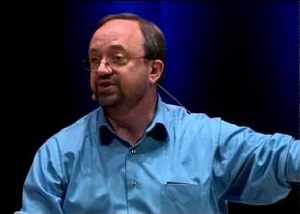
STARFLIGHT CHALLENGES AND OPTIONS
To send a spacecraft to our nearest neighboring star system (Alpha Centauri is over 4 lys distant) within a human lifespan would require a speed of roughly 1,000 times faster than the Voyager spacecraft. The two Voyager spacecraft were launched by NASA about 3 decades ago, and are just now passing through the edge of our solar system, at a distance of roughly 1/500th of a light year.
To increase speed by a factor of 1,000 requires at least 1,000,000 times more energy, and then at least twice more if you want to stop at the destination. And think about the researchers left behind on Earth, the people who build the equipment and the experiments aboard the starship. Considering that a human lifespan is about 100 years (rough orders of magnitude), they’ll be able to track a mission only out 80 light years or so even if it’s moving close to lightspeed. While that might be enough to reach a habitable planet (whose closest distance estimates span roughly 25-ly – 200-ly), the provisional estimates to reach the nearest civilizations (if there are any) are between 500-ly – 6000-ly. [Click for more destination info]. To reach these more profound destinations within the lifetime of the starship builders back home requires either faster-than-light (FTL) flight, or a much longer human lifespan.
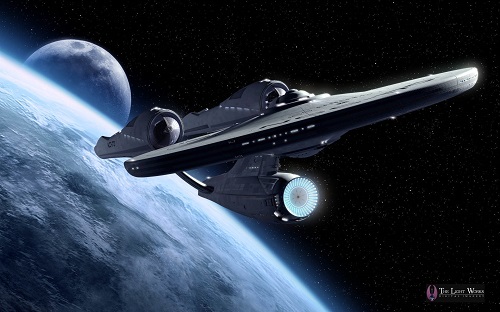
Image: Star Trek‘s Enterprise, an icon of breakthrough propulsion. Credit: The Light Works (www.thelightworks.com).
Absent FTL flight, most starflight researchers explore probe missions based on foreseeable technology. Armed with estimates of what might be ultimately feasible within existing physics, they determine what further technological advancements would be needed to enable meaningful missions. Early projections suggest that probe missions with flight times of only decades might be possible. To develop that technology and to prepare the supporting systems to collect the energy to launch such missions, however, might take several decades or centuries. Those estimates vary wildly depending on which conclusion is being advocated.
When considering human interstellar flight, the prominent concept is to build self-sustaining world ships that can support many generations of humans on their slow journey to eventually reach habitable planets to colonize, or to just coast through space as isolated pockets of humanity. Not much work has progressed toward this theme, since we still do not know the minimum number of colonists required and the minimum life support to keep them going… including what societal structure can sustain peace and satisfying lives in such isolation for so long.
And finally, for those that want to reach “new worlds, new life, and new civilizations” within short attention spans, further physics advances are required. This includes FTL flight and other breakthroughs typical of the Star Trek visions. This motivation includes the desire to usher in a whole new era of profound technological prowess – new technologies enabled by further advances – targeted advances – in physics. Some have characterized this last approach like the crazy uncle who indulges in wild dreams and playful tinkering.
At this stage it is too early to objectively determine which of these pursuits is ‘best,’ in large part because there is no definition of ‘best.’ The motivations, pros and cons are so varied, and the hard facts still so uncertain, that the choice is more based on personal preference. From those I know who work on these, they seem to pick the version that they, as individuals, can contribute the most to making them happen.
Note – the Build the Enterprise website is not about a true starship, but rather something that just looks like the Enterprise with far, far less capabilities. If you are seeking the realization of the Enterprise, keep reading.
FANTASTICAL STARFLIGHT REQUIREMENTS
Star Trek made starflight look easy and other inspiring fiction contributed to our yearnings. According to Jeff Greenwald, in his 1999 book, Future Perfect, about how Star Trek affected people around the world: “… it fulfills a deep and eternal need for something to believe in: something vast and powerful, yet rational and contemporary. Something that makes sense.”
An important element of Trek that went beyond technology is its society: creating a cooperative culture that can harness the power of starflight without killing themselves in the process. In reality, when considering the potency of the energy required for real starflight, this is critically important. This subject could be book unto itself, and why societal and human aspects are an integral part of contemplating real starflight. Personally, I am concerned that this challenge might turn out to be harder than creating new physics for warp drives and controlling gravity.
Back now to the inspiring spaceflight physics. For fun, and to appeal to a wider fan base, here is a composite of some of the biggest visual inspirations for starflight, our “2001 Millennium Enterprise, C57-D.”
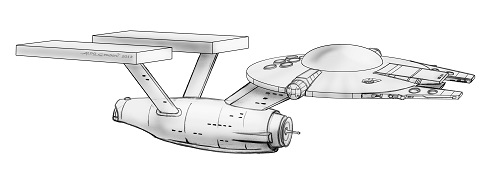
Image: The “2001 Millennium Enterprise, C57-D”, a kludge of favorite fictional vehicles: two alien slabs (with FTL transport capability) from 2001, A Space Odyssey; the 1966 Star Trek Enterprise; the 1977 Millennium Falcon (Star Wars); and the 1956 saucer ship C57-D from Forbidden Planet. Graphic courtesy of Aldo Spadoni, 2013, based on a rough sketch from Millis.
Regardless of your favorite fiction, when it comes to enabling such fantastical star flight, here is what we need:
(I) Faster-than-light (FTL) engines: Compared to the distances between stars, lightspeed is actually slow. It takes years for light to travel the distance between stars. Our nearest neighboring star system (Alpha Centauri) is over 4 years away at lightspeed. The nearest habitable planet might be anywhere from 25-ly to 200-ly distant. And to consider meeting new aliens for each week’s episode, our ship would need a naive cruise speed of at least 25,000 times lightspeed. The word ‘naive’ is used here to remind us that we don’t really know what happens to time and space beyond lightspeed. For traditional slower-than-lightspeed flight, Special Relativity tells us what to expect about our perceptions of time and length changes as we get closer to the lightspeed limit.
(II) Control of gravitational and inertial forces: This is a hugely important feature that often gets neglected in shadow of FTL. It is so ubiquitous in science fiction that many people do not even realize it’s there and it has breakthrough implications – plus it does not yet have a cool-sounding name to convey its essence. Picture your favorite fictional starship – where the crew is walking around normally – as if in a studio back on Earth. This means that the ship is providing a gravitational field for the comfort and health of the crew – in the middle of deep space where such fields do not exist. This would be a profound breakthrough!
But wait, there’s more. Given this ability to create acceleration forces inside a spacecraft, it is not much of a leap of imagination to suggest that acceleration forces could be created outside the spacecraft too – thus propelling the spacecraft. This too – a non-rocket space drive – would be a profound breakthrough.
But wait, again there’s more. The physics of being able to manipulate gravitational and inertial forces also implies the ability to have “Tractor Beams” for moving distant objects, and the ability to sense properties of spacetime that we cannot yet even fathom.
(III) Unprecedented energy storage and power usage: Last on our list of top requirements is having enough energy onboard to power our magical FTL engines and space drives. On Star Trek, they use matter-antimatter to provide energy (which is existing physics), by fully converting matter into energy. Think Einstein’s E=mc2. Our fantastical spacecraft – and even some of the technological versions – will need at least that much energy.
ARE WE THERE YET?
In the book The Physics of Star Trek, physicist Lawrence Krauss compared the visions of Trek to contemporary physics. But it did not go far enough. It only compared the methods of Trek to the physics, rather than the overall requirements, and it did not suggest what we can do about it today.
Progress toward Trek-like ambitions is actually being made. Notions of controlling inertial and gravitational forces, plus FTL flight, ceased to be just science fiction decades ago. Here is that legacy of some of pertinent publications:
1963 Induced Gravitation: Forward, R. L. “Guidelines to Antigravity,” in American Journal of Physics, Vol. 31, p. 166-170.
1988 Wormholes: Morris, M. S. & Thorne, K. S. “Wormholes in spacetime and their use for interstellar travel: a tool for teaching general relativity,” American Journal of Physics Vol. 56, p. 395-412.
1994 Warp Drives: Alcubierre, M. “The warp drive: hyper-fast travel within general relativity,” Classical and Quantum Gravity 11, p. L73-L77.
1997 Space Drives: Millis, M. G. “Challenge to Create the Space Drive,” AIAA Journal of Propulsion & Power 13(5), pp. 577-582.
2004 Quantum Vacuum Propulsion: Maclay, J. & Forward, R., “A Gedanken spacecraft that operates using the quantum vacuum (adiabatic Casimir effect),” Foundations of Physics 34(3), p. 477 – 500.
2009 Compilation of Approaches: Millis, M. G. & Davis, Eric. W., Frontiers of Propulsion Science, Vol. 227 of Progress in Astronautics and Aeronautics, (AIAA).
To be clear, this does not mean that these breakthroughs are on the threshold of discovery. What is does mean is that these notions have advanced to where they are now attackable problems. In terms of the scientific method, the first step of ‘defining the problem’ has been completed, the second step of ‘collecting relevant data’ is underway, and some ideas have even matured as far as testing hypotheses.
For those who can handle a graduate-level treatise, the first scholarly book on the topic (scholarly means peer-reviewed, objective, with equations and with traceable citations) was compiled by myself and co-editor, Eric W. Davis, with the help of over a dozen contributing authors, and so many reviewers that I can’t remember. In 2009, this book, Frontiers of Propulsion Science, was published as part of the Progress in Astronautics and Aeronautics series of the American Institute for Aeronautics and Astronautics (AIAA).
For those who want just the executive level summary, here are short descriptions, along with some notes about continuing work. I’ve attempted to convey this sanely, between the extremes of sensationalist hype and pedantic disdain:
• Faster-than-Light Flight: Wormholes and Warp Drives are theoretically possible, but our theory is not yet advanced enough to guide their actual construction. These theories are based on, and consistent with, Einstein’s General Relativity. The ongoing progress (I rely on Eric W. Davis to track this for Tau Zero) mostly focuses on the energy conditions – how to lower the energy required and how to create and apply the required ‘negative energy.’ One conclusion already is that Wormholes are more energy-efficient at creating FTL than the Warp Drive. A recent account of those details is available as:
Eric W. Davis, “Faster-Than-Light Space Warps, Status and Next Steps,” paper AIAA 2012-3860, 48th AIAA/ASME/SAE/ASEE Joint Propulsion Conference & Exhibit, Atlanta, GA, (January 9-12, 2012) (abstract).
Recent news about the work of Harold “Sonny” White at NASA’s Johnson Space Center has been a bit exaggerated, but the essence of the work is that it is an attempt to measure spacetime distortions caused by the presence of negative energy. Unfortunately, I do not have an article to cite about that hypothesis or the methods being used, since such information has not (yet?) been published. Although Eric Davis is tracking this for Tau Zero, even he does not yet know enough to render judgment. We shall have to wait and see, and hope that the information is submitted for rigorous review.
Additionally, Quantum Physics presents some tempting phenomena that might be relevant to FTL pursuits. A number of phenomena, such as ‘tunneling’ and ‘entanglement’ fall under the header of “quantum non-locality” – a term I learned from physicist John Cramer at the University of Washington, Seattle. That term encompasses the notion that quantum events or phenomena can exist over more than one place at the same time. Cramer’s attempt to test the possible time-paradox implications of such phenomena still remains incomplete. The last update I saw was this publication:
J.G. Cramer, K. Hall, B. Parris, and D.B. Pengra, “Status of nonlocal quantum communication test”, Section 7.2, Univ. Washington CENPA Annual Report 2010-2011, April 2011, pp. 94-95.
But wait, still again there’s more. The hot topics of Warp Drives, Wormholes, and ‘Retrocausal Signaling’ are not the only ways to ponder FTL, but they are the only ones in the peer-reviewed literature, so far. For the budding pioneers amidst us, here is a breakout of other ways of pondering FTL:
Image (click to enlarge): This diagram points out that there is more than one way to ponder FTL. The items in blue boxes are already in the scientific literature, while the remaining green boxes are some of the playful speculations we have heard along the way. Credit: Marc Millis, from the Tau Zero Foundation site.
• Controlling Inertial and Gravitational Forces (in-flight gravitation for crew comfort, maneuvering the ship without rockets, tractor beams, etc.): More than one way to generate acceleration fields has been published and both methods are theoretically consistent with Einstein’s general relativity [Forward’s 1963 paper cited earlier, and the Levi-Civita effect]. Both of these have daunting theoretical and implementation challenges, similar to Warp Drives and Wormholes.
Similar to the FTL work, there is more than one way to approach this challenge, as shown in this graphic:
Image (click to enlarge): There is more than one way to ponder how to create a space drive, and these have been sorted by the physics discipline in which each is based. The items in red boxes have been reliable shown to be dead-ends. Credit: Marc Millis, from the Tau Zero Foundation site.
The details behind this diagram, and the next-step research of each approach are available in:
Marc Millis, “Space Drive Physics: Introduction & Next Steps,” JBIS 65, pp. 264-277 (2012). Abstract available.
This is the area that piques my interest, more specifically the “Space Coupling Propulsion” block in that diagram above. I’ve been working on grant proposals to get that work supported – which involves going back to old works of Eddington and Mach, and scalar potentials where relativity is cast in terms of retarded potentials. For those of you who do not speak that level of geek – I’m trying a different approach to understand the coupling between spacetime (inertial frames) and electromagnetism. The work involves the design and test of new sensors, based on those older perspectives.
• Ample On-board Power: Nuclear power is a technological reality now that, if used for spaceflight, would greatly increase the extent of space activities. The power levels required for interstellar flight, even slower-than-light, are still beyond the accrued prowess of humanity, but optimistic trends suggest they might be achievable sooner than later. The power levels required for faster-than-light (FTL) were once astronomically high, but those values have dropped with continued research to where they are now just fantastically daunting.
Are there new ideas to harness vast amounts of energy? There are credible theoretical and experimental approaches to improve our understanding of “quantum vacuum energy,” but this field is still too young to have developed plausible methods of ample energy exchange. What is possible are miniscule energy conversions when dealing with small electrodes. Today, these serve as good tools to empirically explore this young topic in physics, but are not close to suggesting how to achieve the kind of energy levels needed for FTL flight — levels that might be impossible to achieve..
WHAT YOU CAN DO ABOUT IT
If you want to become a practitioner in pursuit of Star Trek-ish spaceflight, you will need a degree in physics, a vivid imagination, steady rigor to work through the details and persevere through the setbacks, and the personal savvy to navigate amidst a world more interested in short-term returns, and sometimes even back to reruns.
For those who would rather support from the sidelines, Tau Zero will gladly accept donations and is now also open for memberships. If, by some chance, you are a generous philanthropist reading this and wondering if we have what it takes to run a whole program around this theme, the answer is “Yes.” I led the NASA project toward such ambitions, including developing the process to sort through proposals to avoid the detriments of pedantic dismissals and the lunatic fringe. Those details are in the last chapter of our Frontiers of Propulsion Science book. We have a network of qualified practitioners who would gladly assist, even if only for a modest honoraria. And if you are a researcher hoping to find funds for this topic, please let us know if you find any. As yet, we do not have enough funds to invite proposals.
Lastly, I should alert you that there are scams out there on these topics. Rather than risk the legalities of explicit names, please take this advice: If they claim amazing performance – don’t believe it. If they offer no test data to back up their claims, ignore them. If the data they offer has not been independently scrutinized, then look elsewhere. Conversely, the promising signs to look for include: The service providers have a track record of confronting these edgy issues in a manner where increments of progress are published in peer-reviewed journals. Quality practitioners are as open to the possibilities that an idea may or might not work, with the emphasis on getting a reliable answer, instead of hyping the claims or being dismissive.
CONNECTING THE DOTS – ONE VISION
This topic is at such an early stage that it is difficult to project into the future to see how these small steps might lead to the desired breakthroughs. To help fill this gap, I have leaped (below) into wild speculation and conjecture – science fiction, if you will.
First: a dose of reality. Consider how nature has been throwing us curve-balls regarding our physical understanding of space and time. Rotating galaxies do not obey Newton or Einstein, but rather these galaxies hold together as if some “dark matter” is keeping their stars within the galaxies. Next, when viewing our most distant spacetime, we see redshifts that suggest that spacetime is expanding faster than theory – as if some “dark energy” or “antigravity force” were accelerating the expansion of spacetime. Quantum physics, with its incredible predictive power and practical utility, also presents us with oddities like the quantum vacuum energy and non-locality. And finally, consider the Cosmic Microwave Background Radiation, whose properties let it serve as an absolute reference frame for motion relative to the mean rest frame of our Universe. This phenomenon is at odds with assumptions that the Michelson-Morley experiment and the very successful Special Relativity seemed to dismiss the notion of an absolute electromagnetic reference frame. In short, physics is not complete. New discoveries await – discoveries that might open the way for whole new classes of technology.
Now, armed with those uncertainties, consider that other perceptions about the relations between space, time, inertia, and electromagnetism might match nature better. For example, what about the older notions of inertial frames from Mach, Eddington’s other way of describing why light bends in a gravitational field, and the retarded potential perspective of deducing magnetism as a relativistic effect of moving charges. By combining these, it might be possible to first detect, and then induce, perturbations of inertial frames. Such transducers – which convert changes in inertial frames into electromagnetic energy – could reveal new phenomena, new waveforms within inertial frames. Those observations then lead to reversing that conversion – where electromagnetic energy is used to perturb inertial frames – creating momentary gradients that move matter.
This ability would be the beginnings of tractor beams and space drives. From there, imagine when those effects get strong enough to create 0-g recreation rooms on Earth, or 1-g habitats for long-duration, deep spaceflight. Powerful enough devices, ‘space drives,’ could propel spaceships faster and faster. As higher speeds are achieved, experiments to test various FTL theories could commence. Perhaps, just one of those theories might lead to the first FTL transport. And finally, with the combination of non-rocket space drives, cabin gravitation for the crew, and light speed travel… we would have our Enterprise.
Ad astra incrementis
Help us start taking some small risks, today, that might eventually escalate to fantastic starflight – enabling humanity to survive and thrive across the galaxy.

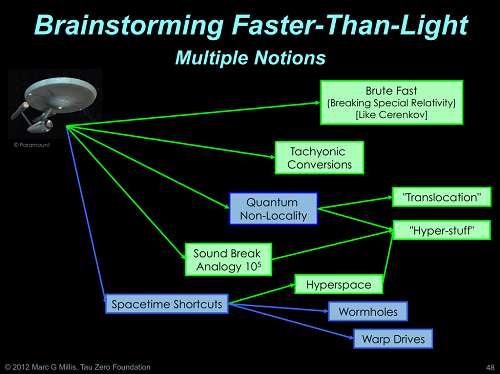
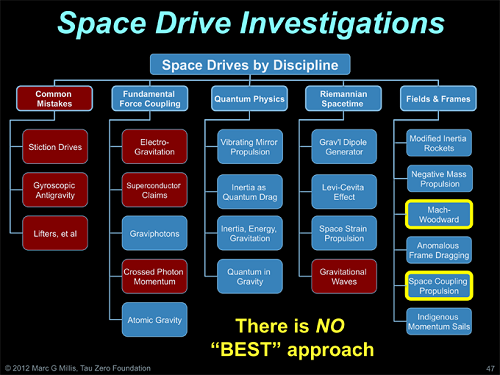


Of interest, there have been papers published on concepts which use hyperspace back in 1979 Alan C. Holt (NASA Johnson Spaceflight Center) published one and I found these two published in 1980 as well:
Hydromagnetics and future propulsion systems
Author: Holt, A. C.
Abstract: Futuristic hydromagnetic propulsion systems for spacecraft are examined with emphasis on systems
NASA Center: Johnson Space Center
Publication Year: 1980
Document ID: 19800052277
Accession Number: 80A36447
Updated/Added to NTRS: Aug 16, 2011
http://ntrs.larc.nasa.gov/search.jsp?R=19800052277&hterms=field+resonance+propulsion&qs=Ntx%3Dmode%2520matchallpartial%2520%26Ntk%3DAll%26N%3D4294693850%26Ntt%3Dfield%2520resonance%2520propulsion
-and-
Prospects for a breakthrough in field-dependent ‘propulsion’
Author: Holt, A. C.
Abstract: If sufficient justification exists to start the development of a field physics laboratory, attention
NASA Center: Johnson Space Center
Publication Year: 1980
Document ID: 19800054809
Accession Number: 80A38979
Report/Patent Number: AIAA PAPER 80-1233
Updated/Added to NTRS: Aug 16, 2011
http://ntrs.larc.nasa.gov/search.jsp?R=19800054809&hterms=field+resonance+propulsion&qs=Ntx%3Dmode%2520matchallpartial%2520%26Ntk%3DAll%26N%3D4294693850%26Ntt%3Dfield%2520resonance%2520propulsion
Peter
I agree with andyet. FTL, wormholes, warp drives, etc, are propeled by exotic stuff that does not exist in our actual universe. Fanciful stuff sort of like alchemy and perpetual motion machines,
Progress is not made by conceding defeat. Even if mastery of gravitational and inertial forces – and FTL – remain impossible, we will learn far more in the attempt than by waxing pedantic.
The cost? We are NOT talking about ‘building’ a whole starship, but only of making progress. Think in terms of graduate work instead of major construction projects. Anything between $0.1M-$6M per Year would make a huge difference. We are not starship shopping yet, we are instead advancing knowledge and abilities.
When the speed of sound was breached was that not considered impossible be fore the event?
CenterOfGravity said on June 5, 2013 at 6:08:
“When the speed of sound was breached was that not considered impossible before the event?”
Heavier than air flight and manned flight in general were also considered impossible by many before they were achieved, in 1903 and 1783, respectively. Then again, most folks back in those eras were not terribly scientific or technologically savvy.
However, compared to them and breaking the sound barrier, which meant going faster than 600-700 miles per hour, these are almost literal walks in the park when you are talking about breaking the speed of light barrier.
There is much more than just going faster involved. Unless you know where some “exotic” matter or a wormhole are available and then know how to construct a vessel than can utilize these items, warp factor 9 is going to be a long time in happening in our reality.
The problem is that people automatically think if someone is saying something cannot be done, especially and ironically if this is said by a trained scientist or engineer, then it is merely a case of bucking the system and in no time at all, the challenge will be met and we will be circling Alpha Centauri tomorrow afternoon.
Most professionals do not balk at warp and other methods of FTL propulsion because they have some personal issue with the concept. They hesitate because they know what is involved to make it happen. It doesn’t cost much or require a lot of thought and work to merely say “The impossible can be made possible.” It also makes the person who says this feel like they are not going to be stuck with the bunch that once said flying through the air or going to the Moon will never happen. Again, these are all much easier than building a starship that can go FTL.
The other problem with focusing on warp drives: It takes away from more immediate methods of interstellar propulsion that we might be able to achieve relatively soon.
Check out Orion, Project Longshot, Daedalus/Icarus, or Starwisp to give you just a few of the more classic real world examples. Even these concepts, which are based in real physics and doable technologies, have numerous hurdles to overcome. We don’t even have a working fusion reactor yet after decades of trying, yet the general public thinks that Zephram Cochrane is out there somewhere right now putting his ship together for launch.
Note that I did not even bring up antimatter driven starships.
So we are not naysaying. We are saying do some homework and let us focus on what we can accomplish with real physics and technology. If someone does come up with a real warp drive, then all the better. But if we get too pie-in-the-sky and spend most of our efforts talking and wishing, we will lose out on the stars for a very long time, maybe forever.
And I haven’t even brought up the fact that the galaxy probably isn’t anything like the depiction in Star Trek, before we go zipping out there and expect to meet Mr. Spock and the rest of the Vulcans.